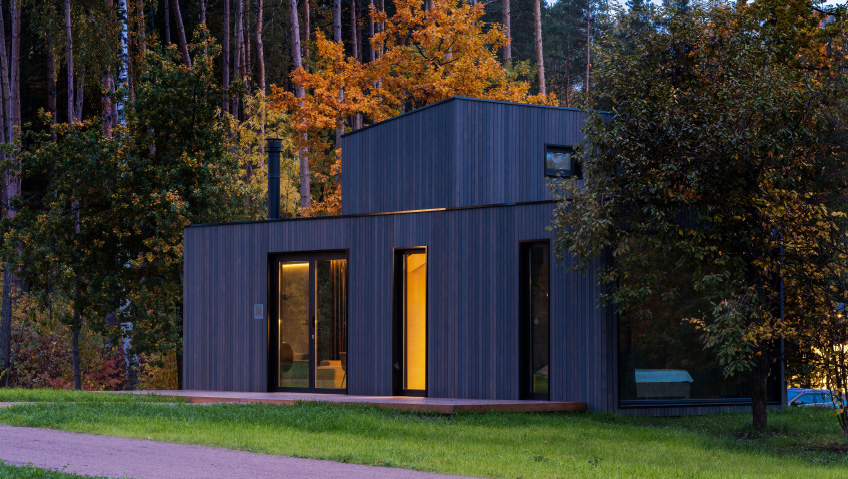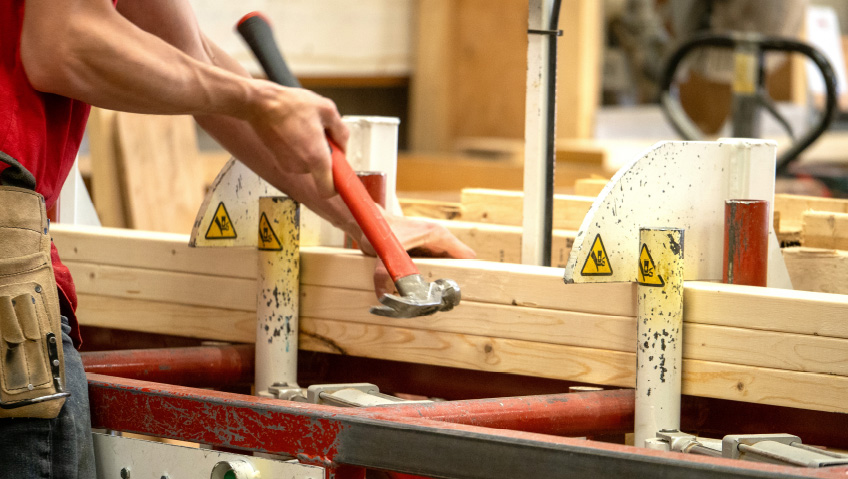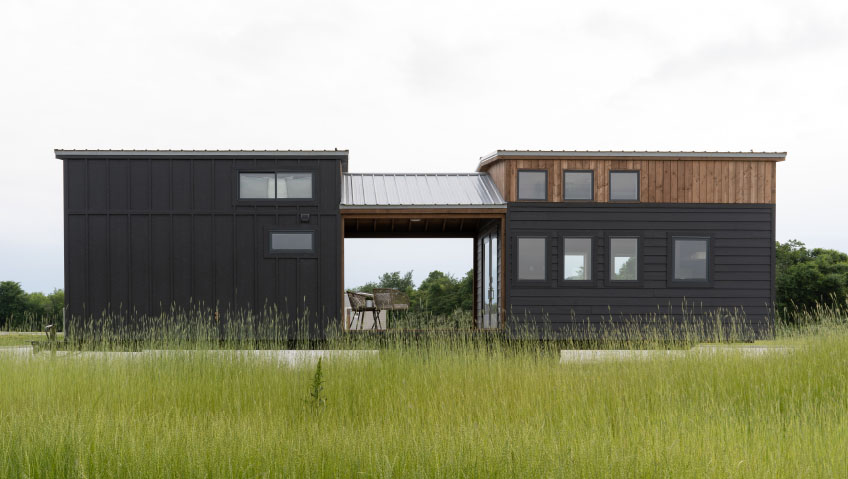From lower costs to faster turnover, modular construction is proving itself to be one of the most viable ways to build. In just a few years, what was once considered an industry upstart has not only become accepted, but embraced as a smarter way to build, for myriad reasons. Unlike traditional construction—which requires a diverse group of industries, subindustries, individuals, and groups from architects and engineers to suppliers to skilled trades like carpenters, plumbers, electricians, bricklayers and others—modular construction is created in factories, not on-site.
From a small house addition to a condominium tower, typical building projects require massive amounts of finished and raw materials such as gravel, sand, stone, concrete, wood, steel, roofing materials, bricks, tiles, insulation, glass, windows, and doors. Not only must the delivery of these materials be coordinated, but so must subcontractors. If wiring, boxes, switches, and electrical panels aren’t on job sites when the electrician arrives, or there are a few missing or damaged boxes of hardwood flooring, installers can’t do their job, wasting clients’ time, money, and precious resources. Modular building is one way of avoiding all these potential pitfalls.
Thinking inside the box
Founded in 1983, the Modular Building Institute (MBI) is the most prominent organization serving the modular construction industry. Based in Charlottesville, Virginia, and with a location in Brussels, Belgium, the MBI is an international, non-profit trade association. Working on behalf of its many members in two distinct industry segments—permanent modular construction (PMC) and relocatable buildings (RB)—MBI’s membership has grown to include general contractors, owners/developers, and architects. “Members of the Modular Building Institute are designing and building the future of the modular/offsite construction industry,” according to the association.
Along with being active in government affairs and research and development, the MBI mandate includes events and education. Over 300,000 industry professionals worldwide receive the MBI’s bi-monthly magazine, Modular Advantage.
From commercial and industrial spaces to housing, the benefits of modular construction are practically limitless, especially when it comes to cost and speed of construction. According to the MBI, “Modular construction is a process in which a building is constructed off-site, under controlled plant conditions, using the same materials and designing to the same codes and standards as conventionally built facilities—but in about half the time.”
While we may think of modular construction as being a recent innovation, the concept actually dates to the 1600s. Wanting to ensure quality construction, a fisherman moving from England to colonial America had his disassembled home shipped across the Atlantic Ocean. In the centuries to follow, early modular construction was used for pre-assembled homes made in New York factories and then shipped to California during the Gold Rush of the 1800s. At one point, Sears, Roebuck, and Co. and Montgomery Ward sold thousands of modular homes. And with America facing a housing crisis after World War II, returning soldiers could purchase reasonably priced modular homes.
How it’s made
Although materials have changed over the decades, many of the fundamentals of modular construction remain the same, including where these structures are manufactured. Unlike traditional wood or brick building on-site, modular spaces are created off-site in factories. This method of manufacturing provides many advantages for purchasers and workers alike. Instead of coordinating tradespeople like carpenters, bricklayers, plumbers, and electricians, transporting them many miles to a job site, and working in all sorts of weather, modular units are factory-made under one roof.
Staff come to the same safe, well-lit, climate-controlled location every workday. They know where all the machinery and supplies are located, and there is no risk of forgetting a tool. There is no risk of materials being delivered late or not at all, since everything workers need is already on hand.
One of the biggest advantages of modular structures is repeatability. Whether 10, 100, or 1,000 units are ordered, they can be created exactly the same way over and over again. And, unlike traditional construction methods, set amounts of material mean less waste is generated.
Some manufacturers are taking sustainability even further, using more sustainable and recycled materials in construction. Depending on the manufacturer, some incorporate recycled steel and plastic in their designs, taking waste out of the environment. Others are incorporating natural materials like straw bales and wool for insulation, or fast-regenerating bamboo.
Addressing worker shortages
For decades, North America largely ignored skilled trades training and introducing younger persons to potential future jobs as electricians, carpenters, or bricklayers. This situation worsened during the pandemic, when many experienced workers called it quits, taking early retirements or leaving construction to pursue other employment opportunities. Now, a year and a half after the Centers for Disease Control and Prevention (CDC) declared an end to the COVID-19 Public Health Emergency (PHE), the shortage of skilled tradespeople continues. Not only is it harder to find experienced trades, but the shortage has greatly increased the cost of living and building.
Enter modular construction. Producing units in factories ensures not only greater consistency, but a high degree of quality control. Typical construction sites depend on trades following one another under the direction of a general contractor. If one is delayed, or fails to show up, projects can be stalled by hours, days, or even weeks. Factory-made modular units avoid these potential issues, since all workers are already present in the same location. And on the permit side, modular homes often receive fast government approval. This will prove especially helpful for getting much-needed, mandated, volumetric low-income housing projects built quickly.
Range of uses
Speed of construction, lower cost, consistency, and other factors make modular construction ideal for everything from housing to office and commercial space. During the pandemic, as hospitals ran out of space and needed to quarantine some patients, modular structures were used as immunization clinics. Some mining and oil & gas sites use modular structures as workforce housing and for storing equipment. And unlike conventional building methods, modular buildings can be erected quickly to create schools, recreation centers, and even entire villages.
Where modular construction truly shines is in the housing market. For years, reports have been issued across Canada and the United States about the shortage of affordable housing to accommodate the needs of growing towns and cities. Typically transported flat to sites, modular homes can be delivered with varying degrees of completeness. Some are shipped as basic boxes, while others come complete with all wiring, plumbing, painted walls, and even furniture. This ultimately means fewer trucks on the road, less pollution, and the ability to make homes move-in ready much sooner.
If current immigration rates continue, Canada will need between 3.5 million and four million more housing units by 2030, according to the Canada Mortgage and Housing Corporation (CMHC). With the shortage of skilled trades—and the increasingly high costs of stick-built construction—modular is truly the answer to helping solve the housing crisis. In the densely populated Province of Ontario, the government issued Building a modular house, a guide under the More Homes, More Choice: Ontario’s Housing Supply Action Plan. Seeking to address the province’s housing crisis, some of the many benefits of modular cited include less likelihood of being impacted by labour shortages, energy efficiency, and being “just as beautiful, functional, and sustainable as any well-built conventional home.”
At the height of the pandemic in mid-2020, global management consulting firm McKinsey & Company published The next normal in construction: How disruption is reshaping the world’s largest ecosystem. Apart from discussing the then-unfolding COVID-19 crisis, the 43-page report detailed emerging trends including modular construction, which grew by an impressive 50 percent between 2015 and 2018 in North America. Comparing factory-made modular units to the automotive industry, the report stated the benefits of “the shift toward a more controlled environment [which] will be even more valuable as the COVID-19 pandemic further unfolds.”
As the demand for cost-effective, sustainable, and efficient construction methods continues to grow, modular construction is poised to play a pivotal role in shaping the future of the industry. By offering speed, consistency, and quality while reducing waste and resource dependency, modular building addresses critical challenges faced by traditional construction. From alleviating housing shortages to creating versatile commercial and industrial spaces, modular construction provides an adaptable solution to the diverse needs of modern society.






